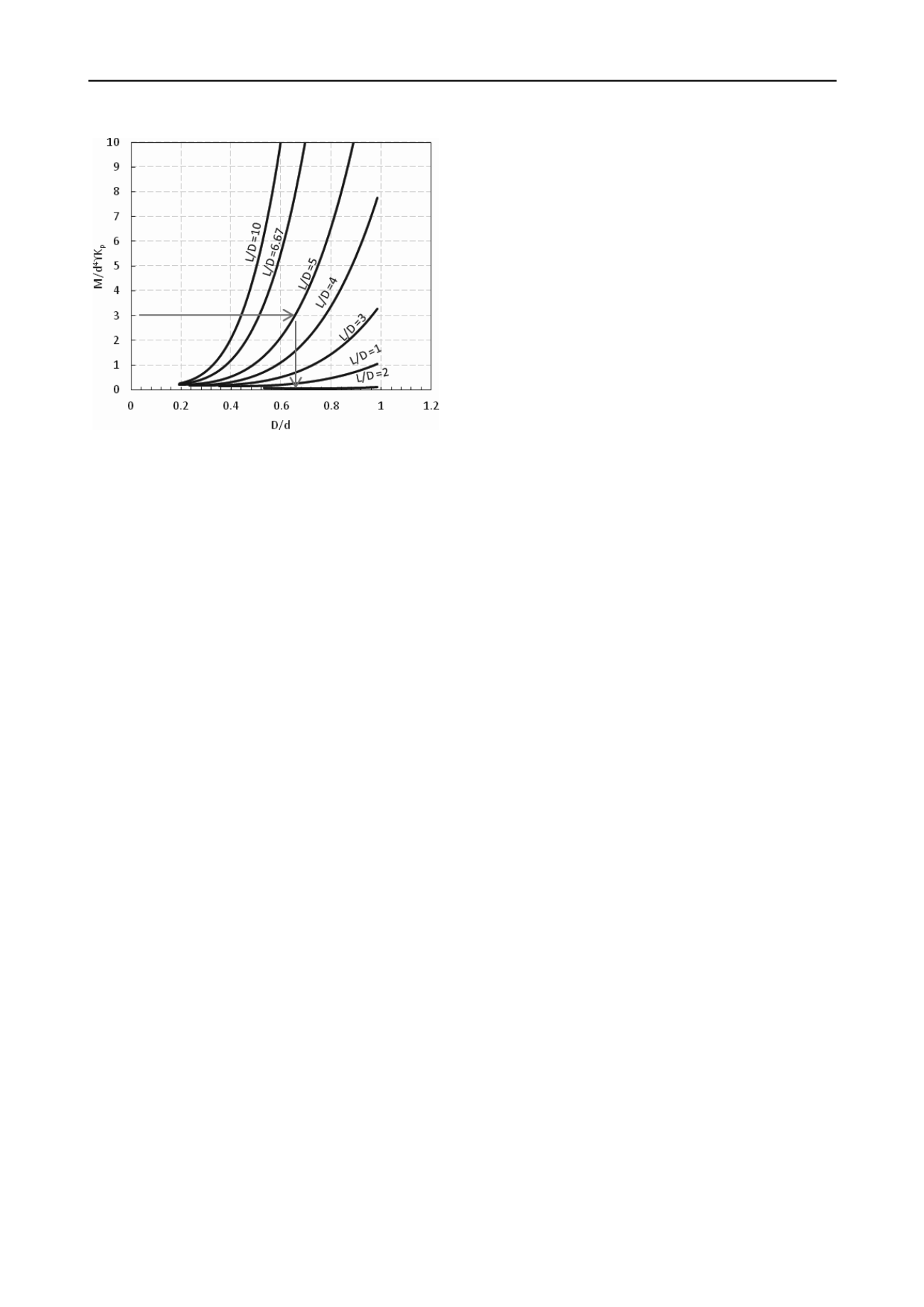
2310
Proceedings of the 18
th
International Conference on Soil Mechanics and Geotechnical Engineering, Paris 2013
Figure 7. Example of a design chart for the hybrid system developed
using analytical and numerical methods.
4. DISCUSSION & CONCLUSION
It is apparent that the ultimate lateral response of a single
monopile foundation can be enhanced by the presence of a
footing resulting in a greater ultimate lateral capacity. This
improvement was observed at both load versus deflection as
well as the bending moment versus depth plots. Whilst the
effect on the initial lateral stiffness may not be significant, the
lateral stiffness beyond this initial movement was significantly
enhanced through the presence of the footing.
The effect of adding skirts to the hybrid system has been
shown to further increase the lateral performance of the hybrid
system, and centrifuge tests are planned to investigate the
skirted system in more detail.
A simple analytical approach using conventional lateral pile
analysis methods is presented from which preliminary design
charts can be generated. This approach can be developed to
generate realistic design charts where the lateral capacity of the
hybrid system is related to the development of bearing capacity
coupled to the lateral resistance of the pile shaft.
5. REFERENCES
Arshi HS. (2011). Structural behavior and performance of skirted hybrid
monopile-footing foundations for offshore oil and gas facilities.
Proceedings of the Institution of Structural Engineers: Young
Researchers Conference ‘11
. London: IStructE Publications, 8.
Arshi HS, Stone KJL and Newson TA. (2011). Numerical modelling on
the degree of rigidity at pile head for offshore monopile-footing
foundation systems.
9
th
British Geotechnical Association Annual
Conference, London
.
Arshi HS and Stone KJL. (2011). An investigation of a rock socketed
pile with an integral bearing plate founded over weak rock.
Proceedings of the 15
th
European Conference of Soil Mechanics
and Geotechnical Engineering
. Amsterdam: Ios Pr Inc, 705 –
711.
Arshi HS. (2012). A new design solution for increasing the lateral
resistance of offshore pile foundations for wind turbines located
in deep-water.
Proceedings of the Institution of Structural
Engineers: Young Researchers Conference ‘12
. London:
IStructE Publications, 10.
Arshi HS and Stone KJL. (2012). Lateral resistance of hybrid monopile-
footing foundations in cohesionless soils for offshore wind
turbines.
Proceedings of the 7
th
International Conference on
Offshore Site Investigation and Geotechnics
. London: Society for
Underwater Technology, 519 – 526.
Bransby MF and Randolph MF. (1998). Combined loading of skirted
foundations.
Géotechnique.
48(5), 637–655.
Broms BB. (1964). Lateral resistance of piles in cohesionless soils.
ASCE Journal of the Soil Mechanics and Foundation Division
.
90(SM3), 123-156.
Duncan JM, Evans LT and Ooi PS. (1994). Lateral load analysis of
single piles and drilled shafts.
ASCE Journal of Geotechnical
Engineering
. 120(6), 1018-1033.
El-Marassi M, Newson T, El-Naggar H and Stone KJL. (2008).
Numerical modelling of the performance of a hybrid monopiled-
footing foundation.
Proceedings of the 61
st
Canadian
Geotechnical Conference, GeoEdmonton 2008
. Edmonton,
(Paper No. 480), 97 – 104.
Gourvenec S and Randolph M. (2003). Effect of strength non-
homogeneity on the shape of failure envelopes for combined
loading of strip and circular foundations on clay.
Géotechnique.
53(6), 575–586.
Houlsby GT and Puzrin AM. (1999). The bearing capacity of a strip
footing on clay under combined loading.
Proc. R. Soc. London
Ser. A
. 455, 893–916.
Kim JB, Singh LP and Brungraber RJ. (1979). Pile cap soil interaction
from full scale lateral load tests.
ASCE Journal of Geotechnical
Engineering
. 105(5), 643-653.
Maharaj DK. (2003). Load-deflection response of laterally loaded single
pile by nonlinear finite element analysis.
EJEG
.
Matlock H and Reese LC. (1960). Generalized solutions for laterally
loaded piles.
ASCE Journal of Soil Mechanics and Foundations
Division
. 86(SM5), 63-91.
Mokwa RL. (1999). Investigation of the Resistance of Pile Caps to
Lateral Loading.
Ph.D Thesis.
Virginia Polytechnic Institute,
Blacksburg, Virginia.
Mokwa RL and Duncan JM. (2001). Experimental evaluation of lateral-
load resistance of pile caps.
ASCE Journal of Geotechnical and
Geoenvironmental Engineering
. 127(2), 185 - 192.
Mokwa RL and Duncan JM. (2003). Rotational restraint of pile caps
during lateral loading.
ASCE Journal of Geotechnical and
Geoenvironmental Engineering
. 129(9), 829 - 837.
Poulos HG. (1971). Behaviour of laterally loaded piles: Part I-single
piles.
ASCE Journal of the Soil Mechanics and Foundations
Division
. 97(SM5), 711-731.
Poulos HG and Randolph MF. (1983). Pile group analysis: a study of
two methods.
ASCE Journal of Geotechnical Engineering
.
109(3), 355-372.
Powrie W, and Daly MP. (2007). Centrifuge modelling of embedded
retaining wall with stabilising bases.
Geotechnique
. 57(6), 485-
497.
Randolph MF. (1981). The response of flexible piles to lateral loading.
Géotechnique
. 31(2), 247-259.
Reese LC, Cox WR and Koop FD. (1974). Analysis of laterally loaded
piles in sand.
Offshore Technology Conference
. Vol. II (Paper
No. 2080), 473-484.
Stone KJL, Newson TA and Sandon J. (2007). An investigation of the
performance of a ‘hybrid’ monopole-footing foundation for
offshore structures.
Proceedings of 6
th
International on Offshore
Site Investigation and Geotechnics
. London: SUT, 391-396.
Stone KJL, Newson TA and El Marassi, M. (2010). An investigation of
a monopiled-footing foundation.
International Conference on
Physical Modelling in Geotechnics, ICPMG2010.
Rotterdam:
Balkema, 829-833.
Stone KJL, Newson TA, El Marassi M, El Naggar H, Taylor RN, and
Goodey RA (2011). An investigation of the use of bearing plate
to enhance the bearing capacity of monopile foundations.
International Conference on Frontiers in Offshore Geotechnics
II - ISFOG.
London: Taylor and Francis Group, 623-628.
Zhang L, Silva F and Grismala R. (2005) Ultimate lateral resistance to
piles in cohesionless soils.
Journal of Geotechnical and
Geoenvironmental Engineering
. Vol. 131(1), 78–83.


